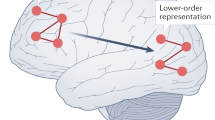Abstract
Literature ranging from hemispheric laterality to meditation has directed our attention to dichotomous, mutually exclusive states of consciousness. Ludwig von Bertalanffy described an encompassing dichotomy and hierarchical principle that suggests a possible approach to finding a synthesis in these dichotomous approaches. This unique approach allows for the simultaneous existence of differing states and focuses upon a hierarchical mechanism which coordinates and reorganizes the properties of these interrelated states. Attention and meditation illustrate how a nondichotomous approach yields implications and possibilities commonly found in daily experience, but excluded by traditional dichotomous approaches.
Similar content being viewed by others
References
BENSON, HERBERT, BEARY, J.F., & CAROL, M.P. 1974. The relaxation response. Psychiatry, 37, 37–46.
BERTALANFFY, LUDWIG VON. 1928. Philosophie des organischen (Theoretische biologie). Literarische Berichte aus dem Gebiet der Philosophie, 18, 5–53.
BERTALANFFY, LUDWIG VON. 1968. General systems theory. New York: Braziller.
BOGEN, JOSEPH E. 1969. The other side of the brain, I, Ii, Iii. Bulletin of the Los Angeles Neurological Societies, 34, No. 3.
BOULDING, K.E. 1966. The impact of the social sciences. New Brunswick, N.J.: Rutgers University Press.
BROADBENT, D.E. 1958. Perception and communication. Oxford: Pergamon.
CHERRY, E.C. 1953. Some experiments on the recognition of speech, with one and with two ears. Journal of the Acoustical Society of America, 25, 975–979.
CRAIK, F.I.M., & LOCKHART, R.S. 1972. Levels of processing: A framework for memory research. Journal of Verbal Learning and Verbal Behavior, 11, 671–684.
DEIKMAN, A.J. 1966. De-automatization and the mystic experience. Psychiatry, 29, 324–328.
DEIKMAN, A.J. 1971. Bimodal consciousness. Archives of General Psychiatry, 25, 481–489.
GAZZANIGA, M.S. 1970. The bisected brain. New York: Appleton.
JACKSON, J. HUGHLINGS. 1864. Loss of speech; its association with valvular disease of the heart and with hemiplegia on the right side. London Hospital Report, 1, 388–471.
JAMES, W. 1890. Principles of psychology. New York: Holt.
KAHNEMAN, D. 1973. Attention and effort. Englewood Cliffs, N.J.: Prentice Hall.
KINSBOURNE, E. (Ed.). 1977. Asymmetrical functions of the brain. New York: Cambridge University Press.
KUBOVY M., & POMERANTZ, J. (Eds.). 1981. Perceptual organization. Hillsdale, N.J.: Lawrence Erlbaum Associates.
MILLER, JAMES G. 1978. Living systems. New York: McGraw-Hill.
NEISSER, ULRIC. 1963. The multiplicity of thought. British Journal of Psychology, 54, 1–14.
NEISSER, ULRIC. 1976. Cognition and reality. Principles and implications of cognitive psychology. San Francisco: Freeman.
ORNSTEIN, R.E. 1977. The psychology of consciousness (2nd ed.). New York: Harcourt Brace Jovanovich.
TENHOUTEN, WARREN D. 1978. Hemispheric interaction in the brain and the propositional, compositional, and dialectical modes of thought. Journal of Altered States of Consciousness, 4, 129–140.
TREISMAN, A.M. 1969. Strategies and models of selective attention. Psychology Review, 76, 282–299.
TULVING, E., & DONALDSON, W. (Eds.). 1972. Organization of memory. New York: Academic Press.
TYSON, P.D. 1982. The choice of feedback stimulus can determine the success of alpha feedback training. Psychophysiology, 19, 218–230.
TYSON, P.D., & AUDETTE, R. 1979. A multivariate approach to the relationship between alpha waves and experience during feedback. Biofeedback and Self-Regulation, 4, 63–79.
TYSON, P.D., & GAVARD, M. 1976. Perceptual compensations for the effects of alcohol. Journal of Studies on Alcohol, 37, 1593–1599.
WASHBURN, MICHAEL C. 1978. Observations relevant to a unified theory of meditation. Journal of Transpersonal Psychology, 10, 45–65.
WATTS, A.W. 1957. The way of Zen. New York: Vintage.
WATTS, A.W. 1975. Tao: The watercourse way. New York: Pantheon.
YOUNG, J.Z. 1971. An introduction to the study of man. New York: Oxford University Press.
ZANGWILL, O.L. 1960. Cerebral dominance and its relation to psychological function. London: Oliver and Boyd.
Author information
Authors and Affiliations
Additional information
The author thanks Stan Sadava, John Benjafield, Joe Kamiya, and Roger Fisher for comments and criticisms during the writing of this paper.
Rights and permissions
About this article
Cite this article
Tyson, P.D. A General Systems Theory Approach to Consciousness, Attention, and Meditation. Psychol Rec 32, 491–500 (1982). https://doi.org/10.1007/BF03394807
Published:
Issue Date:
DOI: https://doi.org/10.1007/BF03394807



